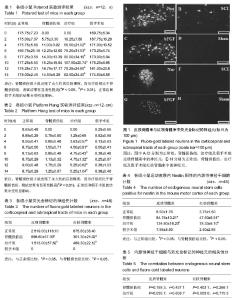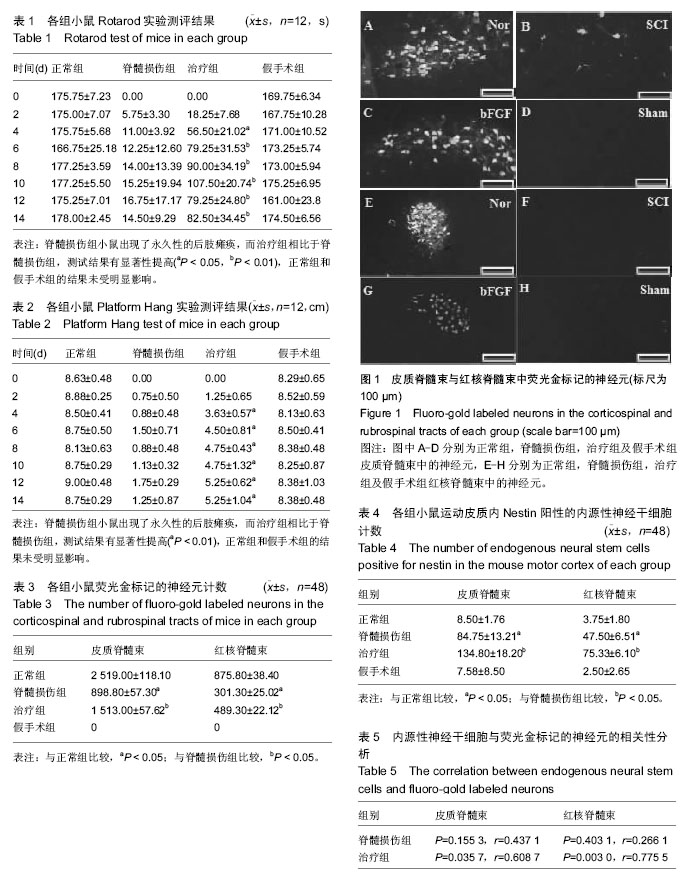| [1] Kempermann G, Wiskott L, Gage FH. Functional significance of adult neurogenesis. Curr Opin Neurobiol. 2004;14(2):186-191.
[2] Liu J, Zang D. Response of neural precursor cells in the brain of Parkinson's disease mouse model after LIF administration. Neurol Res. 2009;31(7):681-686.
[3] Arvidsson A, Collin T, Kirik D, et al.Neuronal replacement from endogenous precursors in the adult brain after stroke. Nat Med. 2002;8(9):963-970.
[4] 张诚,陈刚.内源性神经干细胞治疗脊髓损伤[J].中国组织工程研究与临床康复,2011,15(49): 9275-9278.
[5] Barnabé-Heider F, Göritz C, Sabelström H, et al. Origin of new glial cells in intact and injured adult spinal cord. Cell Stem Cell. 2010;7(4):470-482.
[6] Myckatyn TM, Mackinnon SE, McDonald JW. Stem cell transplantation and other novel techniques for promoting recovery from spinal cord injury. Transpl Immunol. 2004;12(3-4):343-358.
[7] Krupkova O Jr, Loja T, Zambo I, et al. Nestin expression in human tumors and tumor cell lines. Neoplasma. 2010;57(4):291-298.
[8] Lendahl U, Zimmerman LB, McKay RD. CNS stem cells express a new class of intermediate filament protein. Cell. 1990;60(4):585-595.
[9] Mokrý J, Ehrmann J, Karbanová J, et al. Expression of intermediate filament nestin in blood vessels of neural and non-neural tissues. Acta Medica (Hradec Kralove). 2008;51(3):173-179.
[10] Hofstetter CP, Holmström NA, Lilja JA, et al. Allodynia limits the usefulness of intraspinal neural stem cell grafts; directed differentiation improves outcome. Nat Neurosci. 2005;8(3):346-353.
[11] 苏稳,丁鹏,王进昆,等.基质细胞衍生因子1对内源性神经干细胞的趋化迁移作[J].中国组织工程研究,2014,18(6): 950-95.
[12] Reilly JF, Kumari VG. Alterations in fibroblast growth factor receptor expression following brain injury. Exp Neurol. 1996;140(2):139-150.
[13] Yang YL. Effect of adenovirus-mediated basic fibroblast growth factor gene transfer in vivo on oligodendrocyte cell numbers throughout ventrolateral white matter following spinal cord injury in rats. Zhongguo Yi Xue Ke Xue Yuan Xue Bao. 2012;34(4): 348-352.
[14] Galvez-Contreras AY, Gonzalez-Castaneda RE, Luquin S, et al. Role of fibroblast growth factor receptors in astrocytic stem cells. Curr Signal Transduct Ther. 2012;7(1):81-86.
[15] Zang DW, Cheema SS. Leukemia inhibitory factor promotes recovery of locomotor function following spinal cord injury in the mouse. J Neurotrauma. 2003; 20(11):1215-1222.
[16] Kang W, Balordi F, Su N, et al. Astrocyte activation is suppressed in both normal and injured brain by FGF signaling. Proc Natl Acad Sci U S A. 2014;111(29): E2987-2995.
[17] Furusho M, Roulois AJ, Franklin RJ, et al. Fibroblast growth factor signaling in oligodendrocyte-lineage cells facilitates recovery of chronically demyelinated lesions but is redundant in acute lesions. Glia. 2015;63(10): 1714-1728.
[18] Thau-Zuchman O, Shohami E, Alexandrovich AG, et al. Combination of vascular endothelial and fibroblast growth factor 2 for induction of neurogenesis and angiogenesis after traumatic brain injury. J Mol Neurosci. 2012;47(1):166-172.
[19] Furusho M, Dupree JL, Nave KA, et al. Fibroblast growth factor receptor signaling in oligodendrocytes regulates myelin sheath thickness. J Neurosci. 2012; 32(19):6631-6641.
[20] Mudò G, Bonomo A, Di Liberto V, et al. The FGF-2/FGFRs neurotrophic system promotes neurogenesis in the adult brain. J Neural Transm (Vienna). 2009;116(8):995-1005.
[21] Covey MV, Loporchio D, Buono KD, et al. Opposite effect of inflammation on subventricular zone versus hippocampal precursors in brain injury. Ann Neurol. 2011;70(4):616-626.
[22] Zhou Y, Lu Y, Fang X, et al. An astrocyte regenerative response from vimentin-containing cells in the spinal cord of amyotrophic lateral sclerosis's disease-like transgenic (G93A SOD1) mice. Neurodegener Dis. 2015;15(1):1-12.
[23] Urayama S, Semi K, Sanosaka T, et al. Chromatin accessibility at a STAT3 target site is altered prior to astrocyte differentiation. Cell Struct Funct. 2013;38(1): 55-66.
[24] Mutoh T, Sanosaka T, Ito K, et al. Oxygen levels epigenetically regulate fate switching of neural precursor cells via hypoxia-inducible factor 1α-notch signal interaction in the developing brain. Stem Cells. 2012;30(3):561-569.
[25] Moghadam FH, Alaie H, Karbalaie K, et al. Transplantation of primed or unprimed mouse embryonic stem cell-derived neural precursor cells improves cognitive function in Alzheimerian rats. Differentiation. 2009;78(2-3):59-68.
[26] Werner S, Unsicker K, von Bohlenund Halbach O. Fibroblast growth factor-2 deficiency causes defects in adult hippocampal neurogenesis, which are not rescued by exogenous fibroblast growth factor-2. J Neurosci Res. 2011;89(10):1605-1617.
[27] Kirby ED, Muroy SE, Sun WG, et al. Acute stress enhances adult rat hippocampal neurogenesis and activation of newborn neurons via secreted astrocytic FGF2. Elife. 2013;2:e00362.
[28] Tao Y, Black IB, DiCicco-Bloom E. Neurogenesis in neonatal rat brain is regulated by peripheral injection of basic fibroblast growth factor (bFGF). J Comp Neurol. 1996;376(4):653-663.
[29] Dono R, Texido G, Dussel R, et al. Impaired cerebral cortex development and blood pressure regulation in FGF-2-deficient mice. EMBO J. 1998;17(15):4213-4225.
[30] Chang KW, Huang YL, Wong ZR, et al. Fibroblast growth factor-2 up-regulates the expression of nestin through the Ras-Raf-ERK-Sp1 signaling axis in C6 glioma cells. Biochem Biophys Res Commun. 2013; 434(4):854-860.
[31] Timmer M, Cesnulevicius K, Winkler C, et al. Fibroblast growth factor (FGF)-2 and FGF receptor 3 are required for the development of the substantia nigra, and FGF-2 plays a crucial role for the rescue of dopaminergic neurons after 6-hydroxydopamine lesion. J Neurosci. 2007;27(3):459-471.
[32] Zhou YX, Flint NC, Murtie JC, et al. Retroviral lineage analysis of fibroblast growth factor receptor signaling in FGF2 inhibition of oligodendrocyte progenitor differentiation. Glia. 2006;54(6):578-590. |

